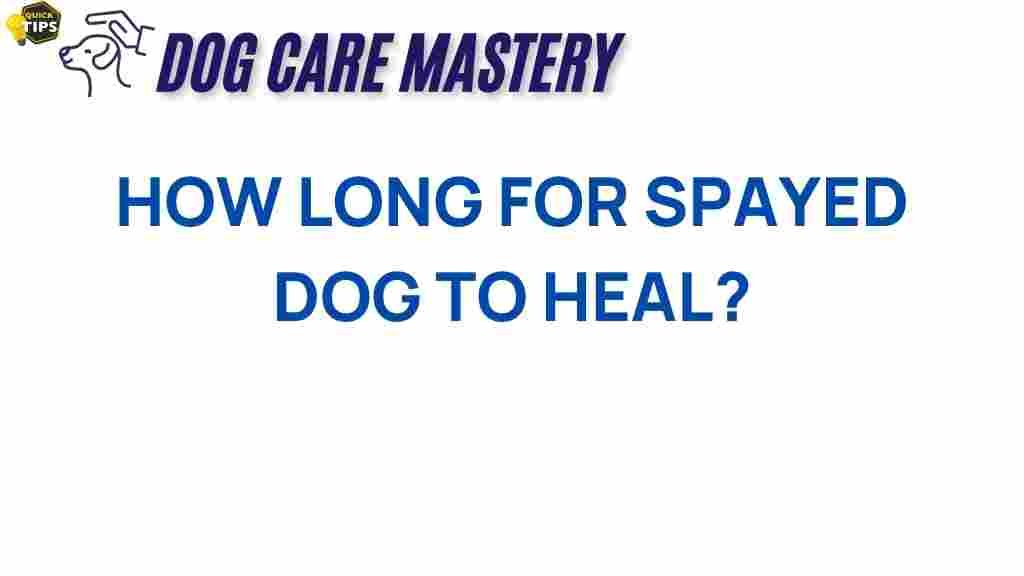Unraveling the Healing Journey: How Long for Spayed Dogs to Recover?
Spaying is a common surgical procedure for female dogs that not only helps control the pet population but also has health benefits for your furry friend. However, it’s crucial for pet owners to understand the recovery process for spayed dogs. In this article, we’ll explore how long it typically takes for spayed dogs to recover, the factors influencing recovery time, and tips to aid their healing journey.
Understanding the Spaying Procedure
Before delving into the recovery process, it’s essential to understand what spaying entails. The procedure involves the surgical removal of a female dog’s ovaries and usually the uterus, which prevents her from going into heat and eliminates the risk of certain health issues.
Spaying is generally performed under general anesthesia, and the procedure can take anywhere from 30 minutes to a couple of hours, depending on the dog’s health and the complexity of the surgery.
What to Expect Immediately After Surgery
After the spaying procedure, your dog will be taken to a recovery area. Once she wakes up from anesthesia, she may be groggy and disoriented. Here’s what to expect:
- Monitoring: Veterinary staff will monitor your dog’s vital signs and overall health.
- Pain Management: Your veterinarian will likely administer pain relief medications to ensure your dog is comfortable.
- Activity Restrictions: It’s crucial to limit your dog’s activity to prevent complications.
How Long Does It Take for Spayed Dogs to Recover?
The recovery time for spayed dogs varies based on several factors, including age, health, and post-operative care. On average, most spayed dogs recover within 10 to 14 days, but let’s break this down further.
Factors Influencing Recovery Time
Several factors can affect how long it takes for spayed dogs to recover:
- Age: Younger dogs tend to heal faster than older dogs.
- Health Status: Dogs with pre-existing health conditions may require more time to recover.
- Procedure Type: Laparoscopic spaying often results in quicker recovery compared to traditional spaying.
- Post-Operative Care: Proper care at home can significantly influence recovery speed.
Step-by-Step Recovery Process
Understanding the stages of recovery can help pet owners provide the best care for their spayed dogs. Here’s a breakdown:
- Day 1-2: Your dog will likely be groggy and may not want to eat much. Keep her comfortable and restrict activity.
- Day 3-5: Most dogs start to regain their appetite. Monitor the incision site for any signs of infection.
- Day 6-10: By this stage, many dogs begin to act more like their usual selves. Gradually reintroduce light activities, but avoid strenuous exercises.
- Day 11-14: Most dogs have healed sufficiently by this time, but it’s essential to follow your vet’s guidance before resuming regular activities.
Post-Operative Care for Spayed Dogs
To ensure a smooth recovery for your spayed dog, follow these care tips:
- Limit Activity: Keep your dog calm and avoid running or jumping for at least two weeks.
- Follow-Up Appointments: Attend all scheduled vet visits to monitor healing.
- Medication: Administer any prescribed pain relief or antibiotics as directed.
- Watch for Complications: Be alert for signs of infection, such as swelling, redness, or discharge from the incision site.
Troubleshooting Common Concerns
As a pet owner, you may encounter some common concerns during your spayed dog’s recovery. Here are some troubleshooting tips:
Appetite Changes
It’s normal for some dogs to experience decreased appetite after surgery. However, if your dog hasn’t eaten for more than 24 hours, contact your veterinarian.
Behavioral Changes
It’s not uncommon for spayed dogs to exhibit changes in behavior, such as increased clinginess or lethargy. If these changes persist beyond a week, consult your vet.
Incision Issues
Monitor the incision closely. If you notice:
- Excessive swelling or redness,
- Foul odor,
- Open wounds or bleeding,
Contact your veterinarian immediately.
Excessive Licking of the Incision
Many dogs will attempt to lick their incisions. To prevent this, consider using an Elizabethan collar or a recovery suit. This will help protect the incision and promote healing.
When to Seek Veterinary Assistance
If you notice any of the following symptoms, seek veterinary care right away:
- Persistent vomiting or diarrhea
- Severe lethargy or unresponsiveness
- Difficulty breathing
- Signs of pain that seem unmanageable
Conclusion
The recovery journey for spayed dogs is an important process that requires care and attention. On average, most dogs will recover within 10 to 14 days, but this can vary based on age, health, and care. By providing proper post-operative care and monitoring for any complications, you can help ensure a smooth healing process for your beloved pet.
Remember, if you have any concerns or questions about your dog’s recovery, don’t hesitate to reach out to your veterinarian. They are your best resource for ensuring your spayed dog heals well and returns to her happy, playful self.
For more information on pet care, check out this resource. If you’re interested in learning more about the importance of spaying and neutering, visit the ASPCA website.
This article is in the category Health and created by dogcaremastery Team
